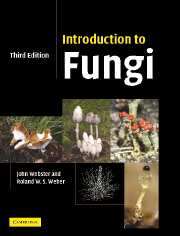Book contents
- Frontmatter
- Contents
- Preface to the first edition
- Preface to the second edition
- Preface to the third edition
- Acknowledgements
- 1 Introduction
- 2 Protozoa: Myxomycota (slime moulds)
- 3 Protozoa: Plasmodiophoromycota
- 4 Straminipila: minor fungal phyla
- 5 Straminipila: Oomycota
- 6 Chytridiomycota
- 7 Zygomycota
- 8 Ascomycota (ascomycetes)
- 9 Archiascomycetes
- 10 Hemiascomycetes
- 11 Plectomycetes
- 12 Hymenoascomycetes: Pyrenomycetes
- 13 Hymenoascomycetes: Erysiphales
- 14 Hymenoascomycetes: Pezizales (operculate discomycetes)
- 15 Hymenoascomycetes: Helotiales (inoperculate discomycetes)
- 16 Lichenized fungi (chiefly Hymenoascomycetes: Lecanorales)
- 17 Loculoascomycetes
- 18 Basidiomycota
- 19 Homobasidiomycetes
- 20 Homobasidiomycetes: gasteromycetes
- 21 Heterobasidiomycetes
- 22 Urediniomycetes: Uredinales (rust fungi)
- 23 Ustilaginomycetes: smut fungi and their allies
- 24 Basidiomycete yeasts
- 25 Anamorphic fungi (nematophagous and aquatic forms)
- References
- Index
- Plate section
25 - Anamorphic fungi (nematophagous and aquatic forms)
- Frontmatter
- Contents
- Preface to the first edition
- Preface to the second edition
- Preface to the third edition
- Acknowledgements
- 1 Introduction
- 2 Protozoa: Myxomycota (slime moulds)
- 3 Protozoa: Plasmodiophoromycota
- 4 Straminipila: minor fungal phyla
- 5 Straminipila: Oomycota
- 6 Chytridiomycota
- 7 Zygomycota
- 8 Ascomycota (ascomycetes)
- 9 Archiascomycetes
- 10 Hemiascomycetes
- 11 Plectomycetes
- 12 Hymenoascomycetes: Pyrenomycetes
- 13 Hymenoascomycetes: Erysiphales
- 14 Hymenoascomycetes: Pezizales (operculate discomycetes)
- 15 Hymenoascomycetes: Helotiales (inoperculate discomycetes)
- 16 Lichenized fungi (chiefly Hymenoascomycetes: Lecanorales)
- 17 Loculoascomycetes
- 18 Basidiomycota
- 19 Homobasidiomycetes
- 20 Homobasidiomycetes: gasteromycetes
- 21 Heterobasidiomycetes
- 22 Urediniomycetes: Uredinales (rust fungi)
- 23 Ustilaginomycetes: smut fungi and their allies
- 24 Basidiomycete yeasts
- 25 Anamorphic fungi (nematophagous and aquatic forms)
- References
- Index
- Plate section
Summary
Throughout this book we have attempted to consider fungi showing predominantly or purely asexual reproduction together with their known or suspected teleomorphs. However, certain groups of taxonomically diverse fungi colonizing the same specialized habitats or substrates are best understood in their ecological context, especially if they show strikingly similar adaptations and morphology despite their different evolutionary histories. Two cases illustrating such convergent evolution among anamorphic fungi are the nematophagous habit and the aquatic habitat, which we shall consider in turn in this chapter.
Nematophagous fungi
Nematodes are a very varied group of invertebrates. They are particularly common as free-living saprotrophic species in the soil, around plant roots, on dung and in all kinds of decomposing plant matter, as well as in freshwater and marine habitats. Most saprotrophic nematodes feed on bacteria, although fungal hyphae may also be consumed. Other species parasitize animals, releasing their eggs or motile stages into the environment when their hosts defaecate. Plant-parasitic species chiefly attack roots as free-living or sedentary organisms. Sedentary species form adult stages inside plant root tissues where they cause the economically important root knot diseases (Meloidogyne spp.) or root cyst diseases (Heterodera spp. and Globodera spp.). Plant-parasitic nematodes are readily recognized because their mouth parts are modified as stylets with which they penetrate plant tissues. Gravid females of cyst nematodes enlarge, and their bodies become converted into a hardened cyst containing the eggs.
- Type
- Chapter
- Information
- Introduction to Fungi , pp. 673 - 701Publisher: Cambridge University PressPrint publication year: 2007
- 2
- Cited by

